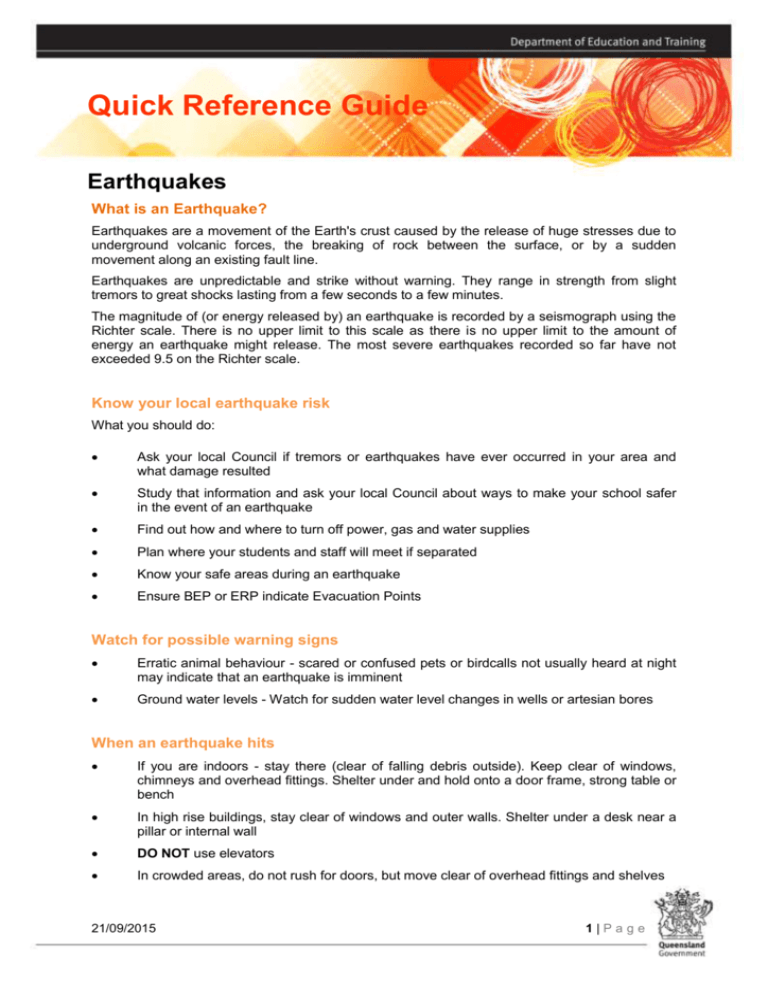Earthquakes - The Department of Education and Training
advertisement

Quick Reference Guide Earthquakes What is an Earthquake? Earthquakes are a movement of the Earth's crust caused by the release of huge stresses due to underground volcanic forces, the breaking of rock between the surface, or by a sudden movement along an existing fault line. Earthquakes are unpredictable and strike without warning. They range in strength from slight tremors to great shocks lasting from a few seconds to a few minutes. The magnitude of (or energy released by) an earthquake is recorded by a seismograph using the Richter scale. There is no upper limit to this scale as there is no upper limit to the amount of energy an earthquake might release. The most severe earthquakes recorded so far have not exceeded 9.5 on the Richter scale. Know your local earthquake risk What you should do: Ask your local Council if tremors or earthquakes have ever occurred in your area and what damage resulted Study that information and ask your local Council about ways to make your school safer in the event of an earthquake Find out how and where to turn off power, gas and water supplies Plan where your students and staff will meet if separated Know your safe areas during an earthquake Ensure BEP or ERP indicate Evacuation Points Watch for possible warning signs Erratic animal behaviour - scared or confused pets or birdcalls not usually heard at night may indicate that an earthquake is imminent Ground water levels - Watch for sudden water level changes in wells or artesian bores When an earthquake hits If you are indoors - stay there (clear of falling debris outside). Keep clear of windows, chimneys and overhead fittings. Shelter under and hold onto a door frame, strong table or bench In high rise buildings, stay clear of windows and outer walls. Shelter under a desk near a pillar or internal wall DO NOT use elevators In crowded areas, do not rush for doors, but move clear of overhead fittings and shelves 21/09/2015 1|Page If outside, keep well clear of buildings, overhead structures, walls, bridges, power lines, trees etc. In a city street, shelter from falling debris under strong archways or doorways of buildings. Don't go under awnings as they may collapse In a vehicle, stop in an open area until shaking stops Beware of downed power lines and road damage, including overpasses and bridges. Listen to your car radio for warnings before moving After an earthquake Turn off electricity, gas, water and DO NOT light matches until after you have checked for gas or fuel leaks Check for injuries and apply first aid. DO NOT move seriously injured people unless they are in immediate danger Check for broken water, sewerage or electrical mains DO NOT use the telephone immediately (to avoid congestion) unless there is a life threatening situation Check for cracks and damage to the roof, chimney etc. Evacuate the building if it is badly damaged and be prepared for aftershocks Do not waste food and water as supplies may be interrupted. Collect emergency water from heaters, ice cubes, toilet tanks and canned foods Listen to your local radio station and heed warnings and advice on damage and service disruptions Try to avoid driving unless for an emergency (to keep the streets free for emergency services) Do not go sightseeing or enter damaged buildings Try to stay calm and help others if possible Prior to the continued use of DET facilities, BAS is to be engaged for a site inspection to ensure buildings are safe for occupation 21/09/2015 2|Page Queensland earthquake map The map shows above magnitude 2 earthquakes in Queensland for the period 1866 - June 2000. Most earthquakes shown on the map were recorded since 1977 when seismographs started to be installed around the State's large dams. From 1977 until 2000, the Queensland seismic network detected and located over 110 earthquakes per year on average. A small fraction of these events were also located by the national seismic network of the Australian Geological Survey Organisation which involved around 3 instruments in Queensland compared to around 30 within the Queensland network managed by QUAKES. Further information about earthquakes Queensland University Advanced Centre for Earthquake Studies Geoscience Australia: Earthquake Information NB: School closures are posted on DET website http://deta.qld.gov.au/natural-disasters.html, Facebook and Twitter. Additional Information For further information contact the Emergency and Security Management Unit on (07) 3034 6012 DET Website http://deta.qld.gov.au/ Twitter www.twitter.com/QLDDETE Facebook http://www.facebook.com/pages/Queensland-Department-of-EducationTraining-and-Employment/136384799716300 21/09/2015 3|Page








